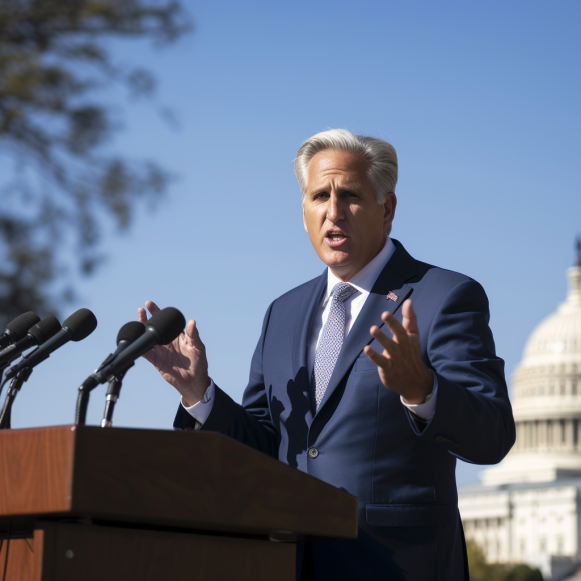Analysis: Sweep or split? Either is likely given Trump, Biden liabilities

WASHINGTON (AP) — With a year to go, the outcome of the 2024 elections is far from certain. With narrow House and Senate majorities and a volatile presidential race, anything from a single-party sweep to a split partisan decision is possible in November.
The Republican Party could have a banner year. Republicans will face an unpopular incumbent and the oldest president in US history in the presidential election, raising questions about President Joe Biden’s ability to serve a second term. They have eight viable chances to gain the two Senate seats required for a majority. And, with North Carolina’s redistricting, the GOP’s chances of retaining the House majority will improve.
However, Democrats have the potential to dominate the table. Democrats have a chance to win the presidential election despite Republicans rallying behind former President Donald Trump, who has been indicted in four different criminal cases and could be convicted before Election Day. This could motivate House candidates to win the five seats required to reclaim the majority. Another round of strong incumbents vs. flawed GOP nominees could help Democrats keep the Senate by a hair’s breadth.
Or the final results could be somewhere in the middle, with the major parties splitting the top prizes.
Despite the fact that the fight for Senate and House majorities is a collection of individual races, the presidential race and the national political environment will set the tone and lay the groundwork for the down-ballot races.
Presidential
With the early primaries still two months away, Democrats and Republicans are poised to re-nominate Biden and Trump, setting up a rematch of the 2020 presidential election. However, this does not guarantee the same outcome.
Instead of being the unpopular incumbent’s alternative, Biden is the incumbent with a mediocre job rating. For the past two years, his job approval rating has been consistently 10 points lower than his disapproval rating, ever since the country’s withdrawal from Afghanistan caused voters to view Biden more skeptically.
Trump lost the shackles of incumbency with his 2020 defeat, but he gained the burden of legal problems never seen before by a major party candidate. Republicans must hope that independent voters are too preoccupied with the country’s current problems to consider the implications of a second Trump term.
Under normal political circumstances, the presidential race will likely come down to six states that Biden narrowly won in 2020 (Arizona, Georgia, Pennsylvania, Wisconsin, Michigan, and Nevada) and one state that Trump narrowly won (North Carolina) as the nominees seek the 270 electoral votes required to win.
The economy and related issues such as the cost of living, inflation, jobs, and fuel prices are likely to dominate the 2024 elections, but each party will highlight issues that benefit their candidates. Republicans will emphasize security issues such as urban crime, immigration, and the southern border, while Democrats will emphasize abortion access.
Foreign policy is one unknown. While foreign policy has been in the back of voters’ minds for the majority of the election cycle, ongoing conflicts in Israel and Ukraine have pushed it into the spotlight. Similar to the war in Iraq in the 2006 cycle, it will almost certainly take American soldiers being deployed and dying for these conflicts to become a top priority. Even if it isn’t a top priority for voters, foreign policy could contribute to an overall malaise under Biden’s leadership, fueling voters’ desire for change.
Fundamentally, Democrats must frame the election as a choice between two unpopular alternatives, rather than a simple referendum on the incumbent. It’s a risky, but not impossible, strategy.
Despite the fact that both Republicans and Democrats are rallying behind severely flawed presidential nominees, each party is so focused on the flaws of the other party’s nominee that they are unwilling to entertain contingency plans if their own candidate fails at the top of the ticket. Because of the high correlation between presidential and congressional results, this lack of foresight could have serious consequences.
Senate
In the midst of all the talk about incumbents and candidates developing political brands that allow them to outperform and win in hostile partisan territory, voters in the vast majority of states and districts vote for the same party for president as they do for the Senate and House.
In 2020, voters in 97 percent of states with Senate races chose the same party for both the Senate and the president. Maine is the only state that voted for one party for president (Biden) and another for Senate (Republican incumbent Susan Collins). Only five of the 100 senators represent states that voted for the opposing party’s presidential nominee in 2020. That is why the top of the ticket is important.
Against all odds, Democrats increased their majority in 2022. Democrats overcame an unpopular Democratic president, an electorate frustrated with the economy, and having to defend the core of the Senate battlefield with strong incumbents, flawed Republican candidates, and the Supreme Court’s abortion decision motivating abortion-rights voters.
With a year to go, Democrats have some of the ingredients in place to replicate their success. However, retaining the majority will be even more difficult than before. Democrats did not lose a single incumbent last cycle, but the competitive races were not in states Trump won in 2020. Democrats failed to win a Senate seat in any of Trump’s states in 2022, and even lost a race in a state Biden carried in 2020 (Wisconsin).
This cycle, they are likely to need at least two incumbents to win in states that Trump easily won, such as West Virginia’s Joe Manchin III (who won by 39 points), Montana’s Jon Tester (Trump +16), and Ohio’s Sherrod Brown (Trump +8). If the president falters at the top of the ticket and fails to carry states he won narrowly in 2020, including Arizona, Nevada, Pennsylvania, Michigan, and Wisconsin, Democrats may need to win Senate races in a half-dozen states that Biden loses.
Republicans should win the Senate majority on paper. Democrats are defending nine of the ten seats rated competitive by Inside Elections, including former Democratic Sen. Kyrsten Sinema’s seat in Arizona, which she now holds as an independent. Republicans have more than enough chances to secure the two seats required for a majority. They could also take control of the Senate with a single seat and win the White House because a Republican vice president could break a tie vote. Biden’s job approval rating is consistently low, and concerns about his age may outweigh some of Republicans’ flaws.
However, the Republicans must still win the elections. Democratic incumbents will be well-prepared and well-funded once more. Republicans have been unable to avoid primaries in key states, and they may face a general election battle with flawed or inexperienced nominees.
A Trump victory would help Republicans win the Senate, but it is unlikely to be necessary. Trump could win West Virginia, Montana, and Ohio by large enough margins to aid Republican challengers while still losing the presidency.
House
Like in the Senate, there is a strong correlation between the top of the ticket and House races. In 2020, the same party won the House and the presidency in 96 percent of congressional districts (419 of 435).
To retake the House majority after two years in the minority, Democrats need only a net gain of five seats out of 435. However, based on the individual races, it appears to be a steeper climb.
Inside Elections has rated 73 races as competitive. If the Republicans win all of the races in which they are favored (all of those rated Solid, Likely, Lean, and Tilt GOP), they will have 217 seats, just one seat short of a majority.
To put it another way, Republicans would only need to win one of the 12 Toss-up races to keep control of the House. Democrats, on the other hand, would need to win all of the races in which they are favored (including the newly redrawn 2nd District in Alabama) as well as all 12 of the Toss-ups in order to reach 218. A new map drawn by Republicans in North Carolina that calls for Republicans to pick up at least three seats helps to cushion the GOP majority.
It will be easier for Democrats to gain control of the House if Biden wins at the top of the ticket, but it is not entirely necessary. Democrats have 14 takeover opportunities in California, New York, and Oregon, including nine in the Toss-up or Tilt categories, where Biden could do well as he did in 2020 and still lose the overall presidential race. Positive developments in redistricting in New York, Georgia, and Louisiana would also help Democrats’ cause.
A close and competitive presidential election would almost certainly result in a split result, with one party winning the White House and one chamber of Congress while the other party won the other. However, given Biden’s and Trump’s significant liabilities, a lopsided presidential race is possible, with a single-party sweep in either direction.





